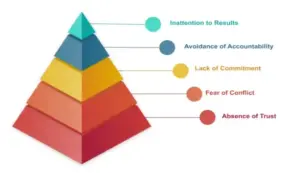“THE FIVE DYSFUNCTIONS OF A TEAM” – BOOK OVERVIEW
As a .NET Technologies Department Lead at Nordlogic, I am always preoccupied with the functional and dynamic aspects of teams, and I try to learn as much as possible through reading books and articles.
There are many approaches to how a team should be built, each relying on a different underlying theory. One of the most interesting ones is described by Patrick Lencioni in his book “The Five Disfunctions of a Team”.
The five dysfunctions of a team model is considered by many as one of the best setups to build teams. What makes it so appreciated and adopted is the simplicity of the principles, their flexibility and the fact that it doesn’t exclude applying other systems or techniques.
The book starts with a fable where Kathryn, freshly appointed CEO of the fictional DecisionTech, faces challenges in the leadership team that could make or break the company. This is meant as a way to ease the reader into the model and give lifelike situations on what could happen or what are the pitfalls of applying the system and redefining the team.
A pyramid, depicted below, is used to display the dysfunctions, because the author sees them as deriving one from another, one layer to the next, with the “absence of trust” at the base. Addressing each potential dysfunction provides the steps one needs to take in order to build a highly functional team.

Trust is the foundation of a functioning team.
Trust is the foundation of a functioning team. In Leoncini’s view, teammates must be comfortable being vulnerable with one another and be confident that those vulnerabilities like weaknesses, interpersonal shortcomings, mistakes, requests for help won’t be used against them. The idea is that once team members are open they can centre their attention on doing the job rather than being political and focus their attention on managing their interactions. One particular exercise the author suggested to aid in improving trust is Team Effectiveness Exercise, where each team member identifies one most important contribution of each colleague and one thing they must improve or eliminate to improve the team.
The aim of the productive conflict is to produce a positive and productive idea in a certain amount of time.
Once trust is established within the team, conflict is made possible because team members are no longer avoiding debating about ideas.To clarify, conflict is limited to concepts and ideas and personal attacks and malicious comments are not tolerated. The aim of the productive conflict is to produce a positive and productive idea in a certain amount of time. Most teams avoid conflict in order to keep a sense of harmony and avoid hurting personal feelings, when actually doing this may fester resentment and in the long run waste time finding solutions. One technique I’ve found interesting in this section of the book is called Mining, when somebody tries to extract buried disagreements in order to work on them.
Conflict enables teams to commit without perfect information.
On the next item, the author identifies desire for consensus and the need for certainty as the two main sources of lack of commitment. In great teams, members generally accept that they don’t need their idea adopted in order to get to consensus, but they do want to have their opinion heard and weighed. Not all scenarios and situations permit a full view of the situation, but it’s important to make a decision with the available information and then boldly change course when more information is available. Conflict enables teams to commit without perfect information. One of the recommended techniques is Cascading Messages, when at the end of the meeting key decisions are reviewed, it’s decided what information is relayed to further parties and ensures all colleagues have the same understanding of the decisions.
Everybody can be held accountable by their colleagues for behaviours and performance that may hurt the team.
Once the team has committed and there is a measure of what’s expected, accountability in the context of teamwork will mean everybody can be held accountable by their colleagues for behaviours and performance that may hurt the team. Far from the common belief, as being a source of damaging work relationships, Leoncini sees this process as a way to avoid deterioration of morale and to decrease resentment. I think this is a sensitive area and a problem even in more mature teams. Especially in cultures where this process can be perceived as criticising others, establishing clear team rules is needed. Steps like Publication of Goals and Standards, Simple and Regular Progress Reviews are self explanatory and will help to make team members accountable.
A lot of teams are not focused on the results.
The final main dysfunction of a team is the inattention to results. Every team defines what it wants to achieve in a certain period of time and these goals make up the desired results. A lot of teams are not focused on the results, meaning they actually lack the desire to succeed. Two of the things that can stay in the way of success are putting too much emphasis on the Team Status or Individual Status.* Team Status* means that people are content with being part of the team and, while certain objectives might be beneficial, they are not worth for them to change the status quo. Any team can be affected, but especially political organisations, well established companies are prone to have this dysfunction. Individual Status means that individual people from within the team put their careers and positions on a much higher level than the actual team. As for things that can help teams to commit to their goals, Public Declaration of Results is one of the ways for teams to commit to their goals. They publicly declare what they want to accomplish and this public acknowledgement should give them the motivation to strive to achieve them.
The importance of the leader
The importance of the leader or a leading figure within the team is stressed by Leoncini. By example, he/she can apply a concept first in order to encourage the team members. On the trust step, to be the first person embracing vulnerability in order to promote openness. The impulse of a leader during conflict is to try to defuse it and calm the situation. The author’s idea is to fight this impulse to keep things under control and protect the colleagues, and let the conflict get to a resolution on its own (as long as it’s within reasonable parameters). As for commitment, he/she usually is the first one that needs to make peace with the idea that the decision taken today might be wrong tomorrow. When the leader is the only source of discipline, it overrules the accountability that may be raised at the team’s level. The trick here is to know when to let colleagues be accountable among themselves and when it’s the case to intervene. A leader focused on the actual results and less on other factors instils in the team the importance of the actual team goals.
Final words
The principles are pretty broad and they are flexible and easily adaptable to suit your organisational context. You can always define what each step means in your team context, what can be digested within the team and what needs outside intervention. Usually, a team works best when it can manage itself, and the 5 main ideas Leoncini describes can be those exact broad ideas that guide your team. Of course, because of their broadness they can be adapted and even intermingled with other systems. The beauty of the model has simplicity at its core. It’s easy to understand, pretty straightforward and can help committed teams to improve continuously. After all, it all sums up on following a small set of steps over and over again.
On the other hand, there is also criticism of the model and not all of it is without merit. One of the main ones is that the author bases most of the content on personal experiences and not actual scientific data. Some ways to achieve the desired results, like sharing of personal experiences to make yourself vulnerable and gain trust within the team or using the Myers-Briggs Type Indicator to indicate the typologies of team members can be questioned.
This system can be implemented almost in any context or organisation as long as there is willingness to do things better. From our perspective, as a custom software development company we were pleased to see some techniques already used at the process level and within our teams, and we believe the model can be applied even in mixed outsourcing teams, with people from different organizations and cultures.
As with every material, book, article or other source, take it through your own personal filter. I personally agree with most of the principles and ideas. I don’t necessarily agree with all the ways the author sees to achieve them, but I do see the book as a great resource to add to your arsenal.

